List of oldest church buildings
This article lists some but by no means all of the oldest known church buildings in the world. In most instances, buildings listed here were reconstructed numerous times and only fragments of the original buildings have survived. These surviving freestanding buildings were purposely constructed for use by congregations (or used at an early date). The dates are the approximate dates when they were first used by congregations for worship.
"Church" may be used in the sense of "Christian denomination" or in the singular as the Christian Church as a whole. The "church" (Greek ekklēsía, assembly) is traced to Pentecost and the beginning of the Christian mission in the first century and was not used in reference to a building.
According to the Catholic Encyclopedia the Cenacle (the site of the Last Supper) in Jerusalem was the "first Christian church."[1] Archaeology magazine suggests that the Dura-Europos church in Syria is the oldest surviving church building in the world,[2] while Jordan's Aqaba Church is considered to be the world's first purpose-built church.[3] Several authors have cited the Etchmiadzin Cathedral (Armenia's mother church) as the oldest cathedral.[4][5][6][7][8][9]
Also St. Thaddeus Monastery or Qara Kelisa[10] (means black church) in Chaldoran County, Iran is noted by UNESCO World Heritage Centre as related to the 66 AD. "According to Armenian tradition such a location was chosen because saint Thaddeus built the earliest church--parts of which are still believed to be in place as the base of the old section--upon the ruins of the temple."[11] In the 66 AD, he as one of the Apostles and SanDokht (the daughter of the King or daughter of Abbot Simeon) and other Thaddeus' devotees were tortured and executed by Armenia's King Sanatrouk or Sanadruk.[11][12][13]
Early Christianity
Church buildings of the 2nd to 4th centuries, either excavated archaeologically or substantially preserved.
Africa
| Building | Image | Location | Country | Oldest Part | Denomination | Notes |
|---|---|---|---|---|---|---|
| Monastery of Saint Anthony |  |
Eastern Desert | Egypt | 356 | Coptic Orthodox | Partially destroyed in the 11th century and rebuilt; very little of the original structure remains. |
| Monastery of Paromeos |  |
Wadi El Natrun | Egypt | 335 | Coptic Orthodox | Built by St. Macarius the Great, its name (Pa-Romeos) which in Coptic means "The Romans" is thought to refer to his two Roman disciples Saints Maximus and Domitius sons of the Roman Emperor Valentinian II. The Monastery flourished during the Middle Ages and continues to be a major monastery within Egypt. |
| Monastery of Saint Macarius the Great |  |
Wadi El Natrun | Egypt | 360 | Coptic Orthodox | Built by St. Macarius the Great, Who was a father for more than 4000 Monks of different Nationalities. It has been continually inhabited since its construction and has experienced renovation and expansion in the 20th century. |
| Debre Sina | Anseba | Eritrea | <383 | Eritrean Orthodox | It was the site of the first Holy Communion prepared in the Eritrean Orthodox Church, by the 4th-century bishop Aba Salama.[14] | |
| Monastery of Saint Pishoy | 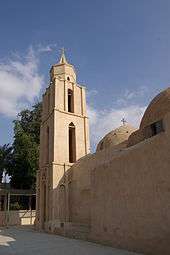 |
Wadi El Natrun | Egypt | 4th Century | Coptic Orthodox | Built by St Pishoy, his body was moved to the monastery on December 13 in 841 AD. The Monastery contains five Churches and a Keep, constructed in the 5th century AD, for protection against Berber raids. The Monastery has been raided several times by the Berbers throughout the ages, the most famous incident is when forty of the Monasteries elders were martyred and thrown in a neighboring well, consequently called "The Well of Martyrs". |
| Monastery of Saint Mary Deipara | 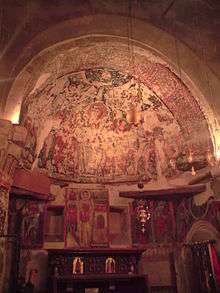 |
Wadi El Natrun | Egypt | 4th Century | Coptic Orthodox | Most commonly known as "Syrian Monastery". Some sources claim that Monks had lived there since the 4th century, but it is most commonly believed that it Was established in the 6th century by monks from the Monastery of St. Pishoy who rejected the Julian Heresy, which claimed that Christ was incorruptible. As a result, they abandoned the Monastery and established a new one which they named after the Theotokos, to emphasize that they believed in Christ's humanity and corruptibility. The Monastery was bought by Syrian Merchants in the eighth century and inhabited by Syrian Monks. |
| Abu Mena Basilica and Complex | Alexandria | Egypt | late 3rd century | Coptic Orthodox | Built near the place at which the Body of St. Mina the Martyr was buried, the Basilica was ordered to be built by Emperor Zenon after the Saint healed his leper daughter. A Monastic community and a city eventually sprang up near the Basilica and it became a famous site of pilgrimage. Terracotta pots with the image of the Saint and spices from his body have been found all throughout the Roman Empire and as far north as Germany. The City complex and Basilica as well as the Monastery were sacked and destroyed in the 7th century by the Arab invaders. The ruins are currently a UNESCO World Heritage site. | |
| Monastery of Saint John the Short | _-_John_Kolobos.jpg) |
Wadi El Natrun | Egypt | 4th century | Coptic Orthodox | Built by Saint John around his "Tree of Obedience". The Monastery remained open until the 17th century when it was finally abandoned. Originally the body of St. John was in a Church near modern-day Suez, Egypt, but his disciples moved it to the monastery in 515 AD. |
| Monastery of Saint Moses the Strong |  |
Wadi El Natrun | Egypt | 4th century | Coptic Orthodox | Built by Saint Moses the Strong, who is called the Apostle of Peace. St. Moses was an Outlaw who repented and became a Monk in Sketes. As he progressed in age he became a father unto many, some of whom were criminals following his example. He was ordained a Priest and built a Chapel and a small monastic community around it. In 405 AD St. Moses heard news that the Monastery was going to be sacked, his disciples wanted to pick up arms and defend their home, however he urged them to either stand as Martyrs with him or escape to neighboring monastic communities. He and 7 others remained in the Church as it was sacked. Later some of his disciples returned and took his body, and the 7 others, with them to Paramous, where they lay today. The Monastery has remained desolate to this day. |
| Church of Our Lady Mary of Zion |  |
Axum | Ethiopia | 4th century | Ethiopian Orthodox | Originally built in the 4th century
, it has been rebuilt several times, most recently in the 17th century during the reign of Emperor Fasilides. |
Asia
| Building | Image | Location | Country | Oldest Part | Denomination | Notes |
|---|---|---|---|---|---|---|
| Monastery of Saint Thaddeus | 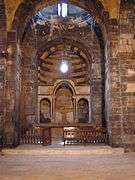 |
Chaldoran County | Iran | c. 1st or 2nd AD[11][12] | Early Church | During the repetitive wars in Iranian history, the building has been repaired and restored multiple times. |
| Dura-Europos church |  |
Dura-Europos | Syria | c. 241[2] | Early Church | House church. Several walls still standing, oldest images of Jesus discovered within the surviving frescoes of the large baptistry room. Fragments of parchment scrolls with Hebrew texts unearthed containing Christian Eucharistic prayers closely connected with the prayers in the Didache.[15] |
| Megiddo church | Legio near Tel Megiddo | Israel | late 3rd century[16] | Early Church | Ruins discovered on prison grounds in 2005, possibly oldest building constructed as a church ever discovered. It retains mosaic floor decoration with Christian motifs – possibly the oldest building with this feature.[17] | |
| Aqaba Church |  |
Aqaba | Jordan | late 3rd-early 4th century[3] | Early Church | Ruins uncovered in 1988; Remains of an early basilica.[18] Considered to be the world's first purpose-built church.[19] |
| Etchmiadzin Cathedral | 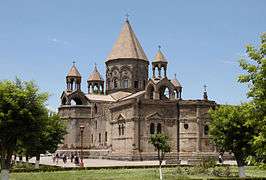 |
Vagharshapat | Armenia | 301 (tradition); current church: 483–484 | Armenian Apostolic Church | According to scholars it was the first cathedral of the world (but not the first church) built in ancient Armenia. |
| Mar Sarkis Monastery | Ma'loula | Syria | 4th century | Syriac Catholic | Built in the 5th century on the remains of a pagan temple, it likely predates the Council of Nicea (325 AD) as evidenced by the fact that it has a round altar, which was prohibited at the Council.[20] The monastery suffered extensive damage and desecration in the Syrian Civil War.[21] | |
| Cathedral of Saints Constantine and Helen | Yabroud | Syria | 326 | Syriac Catholic | Originally built as a pagan temple dedicated to Baalshamin during the first millennium BC, it was converted to a church when Saint Helen passed through the city on her way back to Rome from Jerusalem. The church was damaged during the Syrian Civil War.[22] | |
| Church of the Holy Sepulchre | Jerusalem | Israel | 335 | Simultaneum | Originally completed in 335, the building suffered extensive damage and was almost completely destroyed in 1009. The church was rebuilt in 1038. | |
| Church of the Nativity | 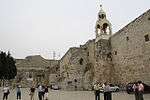 |
Bethlehem | Palestine | 339 | Simultaneum | It was commissioned in 327 by Constantine and his mother Helena over the site that was traditionally considered to be located over the cave that marks the birthplace of Jesus. The original basilica was completed in 339. |
| Mar Mattai Monastery |  |
Mount Alfaf | Iraq | 363 | Syriac Orthodox | Extensively rebuilt over the years with the earliest portions built during the 4th century. |
| Kasagh Basilica | .jpg) |
Aparan | Armenia | 4th or 5th century | Armenian Apostolic | Original building retains many ancient features. |
| Mor Gabriel Monastery | Midyat | Turkey | 397 | Syriac Orthodox | Built on the ruins of an old Assyrian temple, the property is now currently subject to a dispute between the Turkish government and the church. | |
| Jubail Church |  |
Al-Jubail | Saudi Arabia | 4th century | Church of the East | The government hides it from locals and bans foreigners from openly visiting it – even archaeologists.[23] |
| Church of Saint Peter | Antioch (Antakya) | Turkey | 4th or 5th century | Greek Orthodox Church of Antioch | Cave church used by very first Christians of Antioch, where Saint Peter presided as bishop. Known by its original Aramaic name of Knisset Mar Semaan Kefa. Extensively reconstructed, with oldest surviving elements from 4th or 5th century.[24] |
Europe
| Building | Image | Location | Country | Oldest Part | Denomination | Notes |
|---|---|---|---|---|---|---|
| Temple d'Auguste et de Livie or Eglise Sainte-Marie-la-Vieille | Vienne | France | 1st Century | Roman Catholic | Built in the 1st Century as a temple in honor of Augustus and Livia, it became a Catholic Church probably at the beginning of the 6th Century. After 1200 years as Sainte-Marie-la-Vieille, it was converted into a Temple of Reason in 1792 by the French Revolution, then in a Court in 1795, and finally in a Museum from 1822 to 1852. From 1852 to 1880, it was restored to its first appearance. | |
| Cathedral of Saint Domnius | 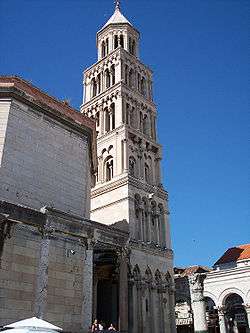 |
Split | Croatia | 295–305 | Roman Catholic | Built 295–305 as the Mausoleum of emperor Diocletian, is the second oldest structure used by any Christian Cathedral. Consecrated in 641 AD, is regarded as the oldest Catholic cathedral in the world that remains in use in its original structure, without near-complete renovation at a later date. |
| Rotunda of Saint George | .jpg) |
Thessaloniki | Greece | 306 | Greek Orthodox | Built as an imperial mausoleum or temple, currently a museum, with church access for various festivities. Largely as built in 305; consecrated later in the century. |
| Santi Cosma e Damiano | 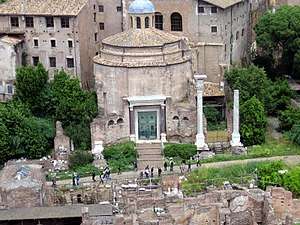 |
Rome | Italy | c. 309 | Roman Catholic | Occupies the former space of the Temple of Romulus in the Roman Forum. |
| Archbasilica of Saint John Lateran | _-_Exterior_2013.jpg) |
Rome | Italy | c. 313-324 | Roman Catholic | Oldest Christian basilica. Was founded after a donation of Constantine the Great to Pope Miltiades, right after the Edict of Milan. |
| Panagia Ekatontapiliani | 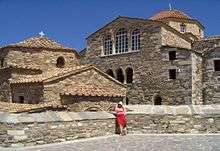 |
Parikia | Greece | 326 | Greek Orthodox | Panagia Ekatontapyliani (also known as the Church of 100 Doors) is a historic Byzantine church complex. |
| Stavrovouni Monastery |  |
Larnaca | Cyprus | 327–329[25] | Greek Orthodox | It was founded by Saint Helena the mother of the Byzantine Emperor Constantine the Great at the place where after a miracle she found the lost Holy Cross on her way back from her pilgrimage to the Holy Land. Saint Helena went on the pilgrimage after the First Ecumenical Synod in Nicaea (325). The monastery has a piece of the Holy Cross left there by Saint Helena. |
| St. Peter's Basilica | 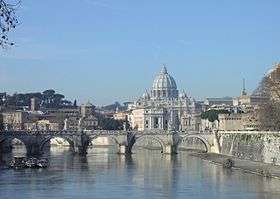 |
Vatican City | Vatican City State | 333 | Roman Catholic | Largest church in the world and the seat of Roman Catholicism, the current church (1635) is built on the site of the original basilica and the grave of St. Peter (who was martyred in Rome).[26] The actual grave is visible in excavations under the church. The original floor and columns are visible in a space under the 17th-century floor. |
| Church of Saint George | Sofia | Bulgaria | 4th century during the reign of Constantine the Great (306–337) | Bulgarian Orthodox | Built by the Romans with many later additions, Saint George is the oldest building in Sofia and the only one dating from the Roman era. Still a functioning church.[27] | |
| Santa Maria in Trastevere | 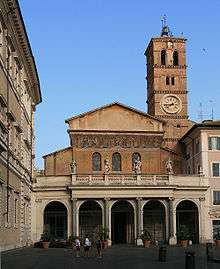 |
Rome | Italy | 340 | Roman Catholic | The first sanctuary was built in 221 and 227 by Pope Callixtus I and later completed by Julius I, but the oldest parts of the present church, the wall structure and floors, date from 340 AD[28][29] |
| Cathedral of Trier | Trier | Germany | 340 | Roman Catholic | Oldest cathedral in Germany, and still in use today. Its construction was overseen by Bishop Maximin of Trier, the construction of the grandest ensemble of ecclesiastical structures in the West outside Rome. A few 4th-century elements remain in a mainly Romanesque building. | |
| Basilica di San Lorenzo |  |
Milan | Italy | 364 | Roman Catholic | When built, it was the biggest circular church building standing. It was an inspiration for the Hagia Sophia in Constantinople. Few ancient features remain. |
| Basilica di San Simpliciano |  |
Milan | Italy | c. 374 | Roman Catholic | Exterior walls are original from the late 4th century. Roman basilica windows as in Cathedral of Trier are still visible on the flanks of the basilica. |
| Basilica of Saint-Pierre-aux-Nonnains |  |
Metz | France | 380 | Roman Catholic | Originally built to be part of a Roman spa complex, the structure was converted into use as a church in the 7th century when it became the chapel of a Benedictine monastery. |
| San Nazaro in Brolo |  |
Milan | Italy | c. 382 | Roman Catholic | One of the earliest Latin cross buildings in western Europe; retains few ancient features.[30] |
| San Paolo fuori le mura | Rome | Italy | 386 | Roman Catholic | One of the four major Constantinian basilicas in Rome, and the only one to retain its antique character, the basilica was heavily damaged by an 1823 fire. It was rebuilt true to form, however, so it remains one of the best "preserved" Constantinian basilicas in the Roman world. All that remain of the ancient basilica are the interior portions of the apse and the triumphal arch.[31] | |
| Santi Giovanni e Paolo | Rome | Italy | 398 | Roman Catholic | A 4th-century basilica was erected on the site of one of the most well-preserved "house churches" of early Christianity (dating from the 1st, 2nd or 3rd century), with intact fresco decoration.[32] The houses are part of a museum currently, but the basilica still functions as a church. | |
| Lullingstone Roman Villa | 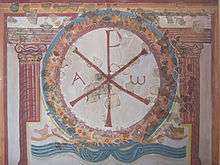 |
Eynsford, Kent | England | 4th century | Early Christian | Room in a large Roman villa turned into a Christian chapel or house church, with wall-paintings surviving (Chi-Rho, largely restored, illustrated) |
| Basilica di Sant'Eustorgio ruins |  |
Milan | Italy | c. 4th century | Roman Catholic | Some ruins remain of the apse of the ancient basilica. |
| Aula Palatina (Konstantinbasilika) |  |
Trier | Germany | 4th century | Evangelical Church in the Rhineland | A Roman palace basilica that was built by the Emperor Constantine at the beginning of the 4th century. The basilica contains the largest extant hall from antiquity. The church was converted to Protestant use from its original Roman Catholic use in 1856.[33] |
| Santi Nereo e Achilleo | 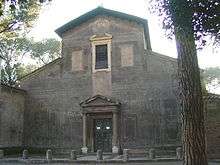 |
Rome | Italy | 4th century | Roman Catholic | Adjoins the Baths of Caracalla at the site where St. Peter is said to have dropped the cloth covering his wounds upon his removal from the Mamertine Prison. First referenced in 336, a 15th-century basilica sits on its original site; only the columns are original.[34] |
| Santa Pudenziana |  |
Rome | Italy | 4th century | Roman Catholic | Retains original and unique late Roman mosaic decoration.[35] |
| San Clemente al Laterano |  |
Rome | Italy | 4th century | Roman Catholic | The present basilica was built just before the year 1100, but beneath it is an intact 4th-century basilica that had been converted out of the home of a Roman nobleman, part of which had in the 1st century briefly served as an early church. This ancient basilica retains fresco decoration (see image). The basement the house had in the 2nd century briefly served as a mithraeum. The home of the Roman nobleman had been built on the foundations of a republican era building that had been destroyed in the Great Fire of Rome in 64 AD. |
| Santa Costanza |  |
Rome | Italy | 4th century | Roman Catholic | Built under Constantine as a mausoleum for his daughter, Costanza. Retains many original mosaic decorations, and her porphyry sarcophagus is a gem of the Vatican Museum. |
| Santi Quattro Coronati | Rome | Italy | 4th century | Roman Catholic | Sanctuary is located in an isolated green area of Rome, so it retains the ambience of the area in antiquity. | |
| Chora Church |  |
Istanbul | Turkey | 4th century | Eastern Orthodox | Very little remains of the 4th-century structure, but it contains impressive 13th-century mosaic decoration. It was converted to a mosque in 1501 and has been a museum since the time of Atatürk.[36] |
| Hagia Irene |  |
Istanbul | Turkey | 4th century | Eastern Orthodox | Now a museum and concert hall (due to its excellent acoustics). Its excellent state of preservation is due to the fact that it lies inside the Ottoman palace complex (Topkapı Palace).[37] |
- Valkum (Fenekpuszta) Built before 433 AD remains of a Bazilika in Hungary near lake Balaton
Late Antiquity and Early Middle Ages
Church buildings dating to between the 5th and 10th centuries.
Africa
| Building | Image | Location | Country | Oldest Part | Denomination | Notes |
|---|---|---|---|---|---|---|
| Saint Catherine's Monastery |  |
Sinai Peninsula | Egypt | 548 AD | Greek Orthodox | Built by Emperor Justinian surrounding St. Helen's Chapel of the Burning Bush. One of the Monasteries was converted into a Mosque by the Fatimid Caliphs in the 10th century and remained in popular use till the 13th century. The Mosque was restored in the 20th century and continues to be used in special occasions. |
| Church of the Virgin Mary in Haret Zuweila | Cairo | Egypt | 10th Century AD | Coptic Orthodox | Served as the See of St. Mark, and the Seat of the Coptic Orthodox Pope of Alexandria from 1400 to 1520. Later a Nun's Convent was added to it in the 19th Century. | |
| Monastery of Saint Paul the Anchorite | 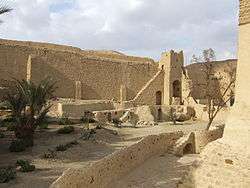 |
Eastern Desert | Egypt | 560 AD | Coptic Orthodox | Partially destroyed in the 15th century and rebuilt; was abandoned in the 16th century, but was later repopulated by Monks from St. Antony's monastery early in the 17th century. |
| Church of Saint Menas | 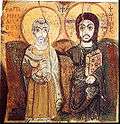 |
Cairo | Egypt | 6th century AD | Coptic Orthodox | Built in honor of the Saint and Martyr, the Church was built within what later was renamed "Cairo". The Church was renovated in the 8th century, and the body of Saint Mena which had been in the ruins of the Abu Mena Complex in Mariout was moved there. The body remained there until a modern Monastery bearing the Saint's name was built adjacent to the ruins, in 1967 the body was moved to the new Monastery. The Church remains open to this day and is a prominent pilgrimage and tourist center in Cairo. |
| Debre Damo |  |
Tigray Region | Ethiopia | 6th century | Ethiopian Orthodox | The best preserved example of Aksumite Architecture. |
Asia
| Building | Image | Location | Country | Oldest Part | Denomination | Notes |
|---|---|---|---|---|---|---|
| Monastery of Stoudios | _Monastery.jpg) |
Istanbul | Turkey | 462 | Greek Orthodox | No longer a functioning church, and was a mosque until it fell into ruin. As with many other archaeological sites in Turkey, plans to revert the ruins back into a mosque are underway.[38] |
| Qalb Loze |  |
Qalb Loze | Syria | 5th century | Assyrian Church | Built in 460s, one of the best-preserved early Syrian churches, the first known with a wide basilica, where the columns that separate the aisles from the nave have been replaced with low piers and soaring arches that create the feeling of expanded space. |
| Church of Saint Simeon Stylites (Deir Semaan) | 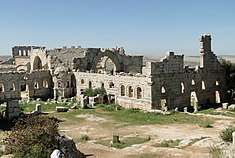 |
Aleppo | Syria | 475 | Greek Orthodox | Once a popular pilgrimage site, now in ruins, but walls still standing. |
| Bolnisi Sioni |  |
Bolnisi | Georgia | 479–493 | Georgian Orthodox | The oldest extant church building in Georgia. |
| Turmanin Basilica | 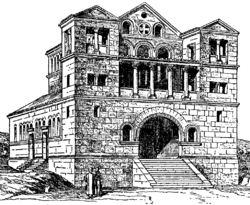 |
Turmanin | Syria | 480 | Early Church | Drawing reconstruction shown. Now in ruins, served a monastery and hospice.[39] |
| Etchmiadzin Cathedral |  |
Vagharshapat | Armenia | 483 | Armenian Apostolic | Built in 483 and heavily rebuilt in the following centuries. Still the main cathedral of the Armenian Apostolic Church. A UNESCO World Heritage Site. |
| Mor Hananyo Monastery | 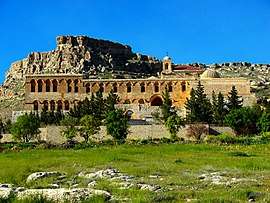 |
Mardin | Turkey | 493 | Syriac Orthodox | Founded in 493 by Mor Shlemon on the site of a temple dedicated to the Assyrian sun god Shamash that was converted into a citadel by the Romans, then transformed into a monastery. Better known as Saffron Monastery. (Deir-ul-Zafran) |
| Dranda Cathedral |  |
Dranda | Abkhazia/Georgia | c. 550–600 | Georgian Orthodox | The oldest church building in Abkhazia, still functioning as a church. |
| Church of the Nativity | .jpg) |
Bethlehem | West Bank | c. 565 | Simultaneum | One of the oldest church buildings in the world which has continuously functioned as a church. |
| Jvari (monastery) |  |
Mtskheta | Georgia | 590–604 | Georgian Orthodox | A World Heritage Site. |
Europe
| Building | Image | Location | Country | Oldest Part | Denomination | Notes |
|---|---|---|---|---|---|---|
| San Vitale | Rome | Italy | 400 | Roman Catholic | Although it was restored several times, the church retains its original structure and walls; it actually sits below street level due to its age and relative lack of major structural renovations. The portico is one of the most ancient parts of the church. | |
| Santa Sabina | 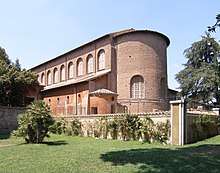 |
Rome | Italy | 422 | Roman Catholic | Mostly unaltered, with some original mosaic decoration and agate window treatments. Notably, wooden doors date from around the same era and contain an early depiction of the crucifixion. |
| San Giovanni Evangelista | 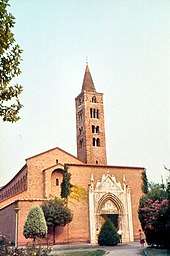 |
Ravenna | Italy | 424 | Roman Catholic | Partially original walls, with original floors and columns under layers of new floors. |
| Santa Maria Maggiore |  |
Rome | Italy | 432 | Roman Catholic | Features intact original mosaic decoration, including some of the oldest depictions of the Virgin Mary. 18th-century façade covers 12th-century façade which replaced the original. |
| Church of the Acheiropoietos | Thessaloniki | Greece | 450–470 | Greek Orthodox | The Acheiropoietos has been dated from its bricks and mosaics to c. 450–470, making it perhaps the earliest of the city's surviving churches. It was modified in the 7th century and again in the 14th and 15th centuries, but retains much of its original character. Known as the Panagia Theotokos in Byzantine times, it is dedicated to Mary. | |
| Santo Stefano Rotondo | Rome | Italy | 455 | Roman Catholic | Believed to be the first church in Rome with a circular plan, inspired by the Church of the Holy Sepulchre in Jerusalem. | |
| Sant'Agata dei Goti | _-_Interior.jpg) |
Rome | Italy | 460 | Roman Catholic | Built for the Arian Goths by Ricimer, this ancient church retains its original site plan and columns, despite many restorations. |
| Stenče Basilica | Polog Valley | North Macedonia | 420–465 | Early Church | To date remains of 16 early Christian basilicas have been revealed in the Polog Valley, of which 12 in Tetovo area and 4 in Gostivar area, and best has been investigated the one in Stenče dating from the 5th century AD, which is unique in Macedonia with 3 baptisteries. | |
| Santa Prisca |  |
Rome | Italy | 4th or 5th century | Roman Catholic | In the interior, the columns are the only visible remains of the ancient church after a 17th-century restoration, but the floor plan remains. A baptismal font allegedly used by Saint Peter is also conserved. |
| Little Hagia Sophia | Istanbul | Turkey | 527 | Greek Orthodox | A former Eastern Orthodox church dedicated to Saints Sergius and Bacchus in Constantinople, converted into a mosque during the Ottoman Empire. This Byzantine building with a central dome plan was erected in the 6th century by Justinian, likely was a model for Hagia Sophia, and is one of the most important early Byzantine buildings in Istanbul. Poorly executed restorations leave the church with a modern character.[40] | |
| Hagia Sophia | 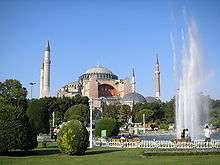 |
Istanbul | Turkey | 532–537 | Greek Orthodox | For almost 1,000 years it was the largest church in Christendom, the main center of worship for the Eastern Orthodox Church, and the jewel of Constantinople. In 1453, it was captured and converted into a mosque, becoming a museum in 1932 under Atatürk. In July 2020, it was turned into a mosque again.[41] |
| Basilica di San Vitale | 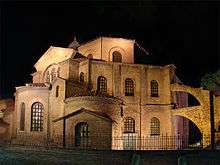 |
Ravenna | Italy | 547 | Roman Catholic | The best-preserved basilica from the time of Justinian I, filled with outstanding Byzantine mosaics in an excellent state of preservation. |
| Saint Sofia Church |  |
Sofia | Bulgaria | 4th century, actual building is from 6th century during the reign of Justinian I (527–565) | Bulgarian Orthodox | The church was built near the Amphitheatre of Serdica. 343 in the building took place the Council of Serdica that was attended by 316 bishops. The current building is from the 6th century. |
| Basilica of Saint Servatius | Maastricht | Netherlands | c. 550 | Roman Catholic | The oldest church in the Netherlands. There was a small memorial chapel on the site dedicated to the Saint Servatius (310–384), who became the first bishop of Maastricht, and this was later replaced by a larger stone church, incorporating the ancient stone. | |
| Dormition of the Theotokos Church, Labovë e Kryqit | 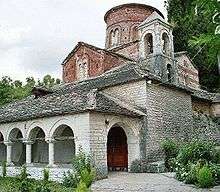 |
Gjirokastër | Albania | 6th century | Albanian Orthodox | The Dormition of the Theotokos Church (Albanian: Kisha e Shën Mërisë) is a church in Labovë e Kryqit, Gjirokastër County, Albania. The foundation on the structure dates from 6th, with the rest from 13th. It is a Cultural Monument of Albania.[42] The present building dates from the 13th century.[43] |
| St. Martin's Church |  |
Canterbury | United Kingdom | 597 | Anglican | The oldest church building in England, still functioning as a church. |
| Church of Saint Apostles Peter and Paul | 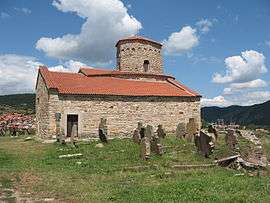 |
Stari Ras, Novi Pazar | Serbia | 6th century | Serbian Orthodox | Also known as Peter's Church (Serbian: Петрова црква / Petrova crkva), it is a Serbian Orthodox church, the oldest intact church in Serbia. It is situated on a hill of Ras, the medieval capital of the Serbian Grand Principality (Rascia), near Novi Pazar, Serbia. It is part of the Stari Ras complex, listed on the UNESCO List of World Heritage Sites in Serbia. The foundations of the structure date from the 6th century, with the rest from the 7th, 9th, and 12th centuries.[44] |
| Chapel of São Frutuoso | Real, Braga | Portugal | 656 | Catholic Church | Visigoth chapel. It has been modified and rebuilt many times. | |
| San Juan Bautista | Baños de Cerrato, Venta de Baños, Castile and León | Spain | Completed in 661 | Catholic Church | Visigoth church built by King Recceswinth in 661 and whose solemn ceremony of consecration is believed to have been on January 3, 661. The excavations carried out in the years 1956 and 1963 found a medieval necropolis of 58 tombs to the northwest of the church and also found three pieces of bronze of the 7th century: 2 lychee-shaped belt clasps and 1 liturgical object. | |
| Santa María de Melque |  |
San Martín de Montalbán, Castile-La Mancha | Spain | 668 | Catholic Church | It served as a monastic ensemble of the Visigoths. The radiocarbon dating of a sample obtained from the conserved part of the original stucco plaster has given a most probable construction date in the interval 668–729 AD. Probably its construction was paralyzed when the arrival of the Arabs began and it was finished and it was reformed later, having suffered multiple historical vicissitudes. |
| Chapel of St Peter-on-the-Wall | 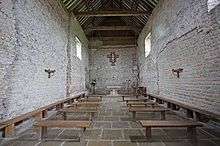 |
Bradwell-on-Sea, Essex | England | 660–662 | Catholic, now Church of England | Early Anglo-Saxon church, reusing Roman brick. Still in use.[45] |
| Escomb Church | 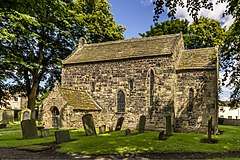 |
Escomb, County Durham | England | c. 670–675 | Catholic, now Church of England | Early Anglo-Saxon church. Still in use.[46] |
| All Saints' Church, Brixworth | 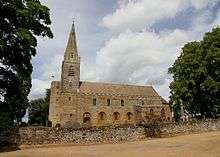 |
Brixworth, Northamptonshire | England | before 675 | Catholic, now Church of England | Early Anglo-Saxon church, with later additions. Still in use.[47] |
| San Pedro de la Nave | El Campillo, San Pedro de la Nave-Almendra, Castile and León | Spain | 680 | Catholic Church | Visigothic church. It must have been built between 680 and 711. | |
| Crypt of San Antolín of the Cathedral of Palencia |  |
Palencia, Castile and León | Spain | 7th century | Catholic Church | Located under the current cathedral of Palencia. It is the only remnant of the primitive Visigothic cathedral built in the second half of the 7th century. The oldest vestige of worship that is preserved today is the bottom of the crypt, a building dating from the middle of the 7th century. The remains of Antolín, noble Gallo-Visigoth, saint and martyr, would have arrived in Spain in the procession of King Wamba from Narbonne in the year 673. Wamba himself would order the construction of the burial. |
| Hermitage of Santa María de Lara |  |
Quintanilla de las Viñas, Mambrillas de Lara, Castile and León | Spain | Completed at late-7th century or early-8th century | Catholic Church | Visigothic hermitage. |
| Church of St John the Baptist, Kerch | 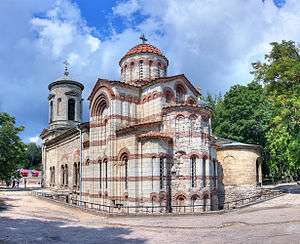 |
Kerch | Ukraine | 717 | Ukrainian Orthodox | Founded in 717, later rebuilt on several occasions. |
| Santa Cruz de Cangas de Onís | 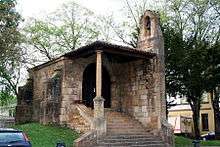 |
Cangas de Onís, Asturias | Spain | Completed in 737 | Roman Catholic | Church of Kingdom of Asturias. t was consecrated in 737. The church was restored in 1633 and 1936. Now it is a World Heritage Site. |
| Church of San Juan Apóstol y Evangelista | 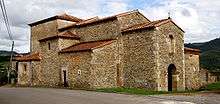 |
Santianes, Pravia, Asturias | Spain | 774 | Roman Catholic | Church of Kingdom of Asturias. Built between 774 and 783. In the church the debate between the Beatus of Liébana and Elipando of Toledo was celebrated, on the adoptionist interpretation of the divinity of Christ. Now it is a World Heritage Site. |
| Oviedo Cathedral | Oviedo, Asturias | Spain | 781 | Roman Catholic | Church of Kingdom of Asturias. It underwent modifications and was enlarged until 16th century. Now it is a World Heritage Site. | |
| Santa María de Bendones | Bendones, Asturias | Spain | 792 | Roman Catholic | Church of Kingdom of Asturias. Built between 792 and 842. It suffered a restoration after Spanish Civil War. Now it is a World Heritage Site. | |
| Aachen Cathedral | 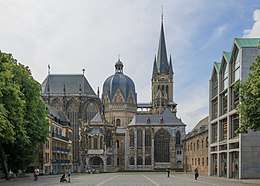 |
Aachen | Germany | 805 | Roman Catholic | It is the oldest cathedral in northern Europe and was constructed by order of the emperor Charlemagne, who was buried there after his death in 814. It is a World Heritage Site. |
| San Julián de los Prados | 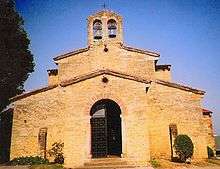 |
Oviedo, Asturias | Spain | Completed in 830 | Roman Catholic | Church of Kingdom of Asturias. The church's construction was ordered by Alfonso II of Asturias and it was built by the court architect Tioda. Now it is a World Heritage Site. |
| Santa María del Naranco | 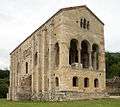 |
Municipality of Oviedo, Asturias | Spain | Completed in 842 | Roman Catholic | Church of Kingdom of Asturias. Built as a banqueting house, later used as a church. It is a World Heritage Site. |
| San Miguel de Lillo |  |
Oviedo, Asturias | Spain | Completed in 842 | Roman Catholic | Church of Kingdom of Asturias. It is a World Heritage Site. |
| Santa Cristina de Lena |  |
Lena, Asturias | Spain | Completed in 852 | Roman Catholic | Church of Kingdom of Asturias. It is a World Heritage Site. |
| Hildesheim Cathedral | 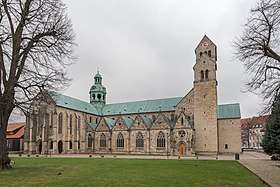 |
Hildesheim | Germany | 872 | Roman Catholic | The original form of the cathedral is still clearly recognizable. It is a World Heritage Site. |
| Great Basilica, Pliska | Pliska | Bulgaria | Completed around 875 during the rule of Knyaz Boris I (852–889) | Bulgarian Orthodox | Architectural complex in Pliska, the first capital of the Bulgarian Empire, which includes a cathedral, an archbishop's palace and a monastery. Completed around 875, the basilica was the largest Christian cathedral in Europe around 1000 years,[48] with an area of 2,920 square metres (31,400 sq ft). The basilica was built at the place of what is known as the Cross-shaped Mausoleum, an older religious building that is thought by some researchers to be an unknown kind of Bulgar heathen temple. According to the Shumen architectural museum's research, an early Christian martyrium that included a cross-shaped church and a holy spring also existed at that place. The martyr buried there is thought to be Enravota, the first Bulgarian saint. The martyrium is thought to have been destroyed in 865 during the failed rebellion of the heathens in the wake of the Christianization of Bulgaria. Other researchers, however, regard the cross-shaped remains as a mausoleum of early Bulgarian rulers. | |
| Church of St. Sophia, Ohrid | .jpg) Rear courtyard |
Ohrid | North Macedonia | 9th century during the rule of Knyaz Boris I (852–889) | originally Bulgarian Orthodox, now Macedonian Orthodox Church | The church was built during the First Bulgarian Empire, after the official conversion to Christianity. Some sources date the building of the church during the rule of Knyaz Boris I (852–889).[49] |
| Round Church, Preslav |  |
Preslav | Bulgaria | Before 907 during the rule of Tsar Simeon I | Bulgarian Orthodox | Large partially preserved early medieval Eastern Orthodox church in Preslav, the former capital of the First Bulgarian Empire, today a town in northeastern Bulgaria. The church dates to the early 10th century, the time of Tsar Simeon I's rule, and was unearthed and first archaeologically examined in 1927–1928. Considered to be one of the most impressive examples of medieval Bulgarian architecture, the Round Church takes its name from the distinctive shape of one of its three sections, the cella (naos), which is a rotunda that serves as a place of liturgy. The church's design also includes a wide atrium and a rectangular entrance area, or narthex, marked by two circular turrets. |
| Iglesia de San Tirso | Oviedo, Asturias | Spain | 9th century | Roman Catholic | Church of Kingdom of Asturias. It was founded in the 9th century. It has undergone various reconstructions and restorations. Now it is a World Heritage Site. | |
| San Pedro de Nora | 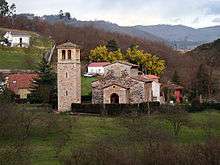 |
Las Regueras, Asturias | Spain | 9th century | Roman Catholic | Church of Kingdom of Asturias. It suffered a restoration after Spanish Civil War. |
| Cámara Santa | 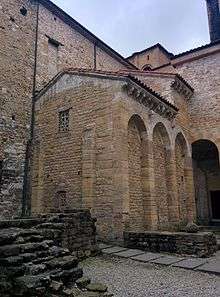 |
Oviedo, Asturias | Spain | 9th century | Roman Catholic | Church of Kingdom of Asturias. Its function, practically from its construction and that it conserves at present, has been the one of guard of the relics and cathedral treasure. It is now a World Heritage Site. |
| San Salvador de Valdediós |  |
Municipality of Villaviciosa, Asturias | Spain | 9th century | Roman Catholic | Church of Kingdom of Asturias. Consecrated in 893. Now it is a World Heritage Site. |
| Santiago de Gobiendes |  |
Gobiendes, Asturias | Spain | late-9th century | Roman Catholic | Church of Kingdom of Asturias. It was restored in three times. |
| Santo Adriano de Tuñón | 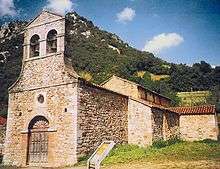 |
Tuñón, Asturias | Spain | 9th century | Roman Catholic | Church of Kingdom of Asturias. Founded in 891. It suffered many reforms. |
| Church of St. Margaret of Antioch | Kopčany | Slovakia | 9th or 10th century | Roman Catholic | The only remaining Great Moravian building. The oldest church in Slovakia. Well-preserved and openly accessible to the public. | |
| Church of San Salvador de Priesca |  |
Villaviciosa, Asturias | Spain | Completed in 921 | Roman Catholic | Church of Kingdom of Asturias. Consecrated in 921. It suffered some enlargements and two restorations. Now it is a World Heritage Site. |
| San Pietro in Trento | Ravenna | Italy | c. 977 | Roman Catholic | Facade restored, but very much intact. Constructed by Galla Placidia. | |
| Boyana Church | Sofia | Bulgaria | late 10th or early 11th century | Bulgarian Orthodox Church | Medieval Bulgarian Orthodox church situated on the outskirts of Sofia, the capital of Bulgaria, in the Boyana quarter. In 1979, the building was added to the UNESCO World Heritage List. The east wing of the two-storey church was originally constructed in the late 10th or early 11th century, then the central wing was added in the 13th century under the Second Bulgarian Empire, the whole building being finished with a further expansion to the west in the middle of the 19th century. A total of 89 scenes with 240 human images are depicted on the walls of the church. |
- The Dead Cities of Syria feature ruins of many churches, all abandoned prior to the 8th century and many dating from the 4th and 5th centuries
- St. George's Church, Rihab, Jordan, 1st to 8th centuries. Dates are contested by experts but area under the church may have been used for Christian worship as early as 33 AD[50][51][52]
- Church of Sts. Constantine and Helen, Yabroud, Syria, 5th century,[53] Built from Roman temple; Desecrated in 2014 by extremists in Syrian Civil War[22][54]
- Al-Aqiser church, built in 500s, oldest church building in Iraq (foundations, some walls remain).[55]
- Saint Elijah's Monastery, near Mosul, Iraq is a 6th-century ruin and among the oldest monasteries in Iraq
- St. George's Church, Izra, Syria, Built in the 6th century[56][57]
- Saint Hripsime Church, built 618 AD in Armenia (Armenian Apostolic)
- The Hanging Church, Built c. 690 on site of earlier church, possibly the oldest church building in Egypt (Coptic Orthodox)
- Ateni Sioni Church, early 7th century, Georgia
- Anchiskhati Basilica, built in the 600s, the oldest church building in Tbilisi.
- São Pedro de Balsemão, built in the 7th century, possibly oldest church building in Portugal (Roman Catholic).
- Densuş Church, built in 600s, oldest church building in Romania
- St Peter's Church, Monkwearmouth, UK, porch and west wall date from 674 AD
- St Paul's Church, Jarrow, UK, parts – including the original dedication stone – date from 685 AD
- St Peter’s Church, Titchfield, Hampshire, UK, some parts remain from c. 680
- St Laurence's Church, Bradford-on-Avon, Wiltshire, UK, Anglo-Saxon, could have been founded by St Aldhelm c. 700 AD, although its style suggests 10th or 11th century.
- Great Church, Elst, Netherlands, church built in the 15th century, built upon and using the remains of two Gallo-Roman temples.
- Gallarus Oratory, built between the 6th and 9th centuries, Possibly the oldest church building in Ireland
- Church of Holy Cross, Nin, built in the 9th century, oldest church building in Croatia (Roman Catholic)
- Kadamattom Church, India, built in the 9th century.
- St. Mary's Forane Church, Kaduthuruthy, India, built in 500 AD. Also known as Kaduthuruthy Valiya Palli[58]
- Church of Ayios Lazaros, Larnaca, built in the 9th century, one of the oldest churches in Cyprus
- Church of SS. Peter and Paul, built at Budeč fortified settlement between 895 and 905 during rule of Spytihněv I is the oldest extant church building in the Czech Republic. The site (cf. cs:Budeč (hradiště)) is located near village of Zákolany, about 17 kilometres (11 mi) NW of Prague.
- Tkhaba-Yerdy Church, Russia, built prior to the 9th century
- Greensted Church, UK, built in the mid-9th or mid-11th century, oldest wooden church building in Europe
- Worth Church, UK, dated c. 950 to 1050 AD.[59]
- Shoana Church, Russia, built c. the 10th century
- Senty Church, Russia, built c. the 10th century
- Church of Tarnaszentmária, built at the end of the 10th century
- The Pantheon in Rome became a church in AD 608.
High to Late Middle Ages
A selection of notable, extant 11th- to 14th-century churches.
| Building | Image | Location | Country | Oldest Part | Denomination | Notes |
|---|---|---|---|---|---|---|
| Dalby church |  |
Dalby, Sweden | Sweden | 1060 | Church of Sweden (Lutheran) | Oldest parts date to around the year 1060 and is therefore considered the oldest building in the nordic countries, however the only remaining parts from that time are parts of one of the walls.[60] |
| Church of Our Lady |  |
Aarhus | Denmark | 1060 | Lutheran | An older wooden church was on the site in the 10th century. The crypt of the church is the oldest extant stone church in Scandinavia. It is still functioning as a church. |
| Cathedral of Pisa |  |
Pisa | Italy | 1063 | Roman Catholic | Built on the foundations of an older church. Dedicated to the Assumption of St. Mary, it is a Primatial church. |
| Santiago de Compostela Cathedral |  |
Santiago de Compostela, Galicia | Spain | 1075 (current church) | Roman Catholic | According to tradition, the Apostle James, son of Zebedee spread Christianity in the Iberian Peninsula. In the year 44 he was beheaded in Jerusalem and his remains were later transferred to Galicia in a stone boat. The king Alfonso II of Asturias ordered the construction of a chapel in 810s in the place. This chapel was followed by a first church in 829 and later by a pre-Romanesque church on 899, gradually becoming an important place of pilgrimage. In 997 this primitive church was reduced to ashes by Almanzor, commander of the army of the Caliphate of Cordoba. The construction of the current cathedral in the same place was built between 1075 and 1122 under the reign of Alfonso VI of León and Castile. The baroque façade of Obradoiro was made in 1740; also baroque is that of Acibecharía; that of Pratarías was built by Master Esteban in 1103; the Pórtico da Gloria, a primordial work of Romanesque sculpture, completed by Master Mateo in 1188. |
| Church of the Holy Mother of God, Asen's Fortress | 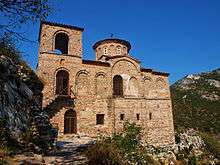 |
Asen's Fortress | Bulgaria | 1100–1200 | Bulgarian Orthodox Church | Medieval Eastern Orthodox church located in Asen's Fortress. It lies near Asenovgrad in the Rhodope Mountains of Plovdiv Province, south central Bulgaria. Constructed most likely in the 12th century, it features two stories, of which the upper story is the church proper and the lower story is of unclear function. The rectangular tower over the church's narthex is regarded as the earliest preserved of its kind in the Balkans. Fragments of frescoes are visible on the walls of the church's upper story. |
| Church of St Demetrius of Thessaloniki, Veliko Tarnovo | 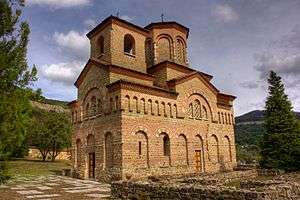 |
Veliko Tarnovo | Bulgaria | 1185 | Bulgarian Orthodox Church | Medieval Bulgarian Orthodox Church in the city of Veliko Tarnovo in central northern Bulgaria, the former capital of the Second Bulgarian Empire. The church lies at the northeastern foot of the Trapezitsa and Tsarevets hills, on the right bank of the Yantra River, outside the city's medieval fortifications. Architecturally, it has a pentahedral apse and a cross-domed design with a narthex and a fore-apse space. It was once part of a large monastery and belonged in its southeastern part. The church's exterior is decorated with blind arches and colourful ornaments: glazed rosettes, suns, rhombs and other painted figures. The church was built of stone alternated with three rows of bricks. It is 15.75 by 8.40 metres (51.7 ft × 27.6 ft) in size. The church was the place where the anti-Byzantine Uprising of Asen and Peter was proclaimed in 1185; it was this uprising that led to the reestablishment of the Bulgarian Empire and the proclamation of Tarnovo for its capital.[61] |
| Holy Forty Martyrs Church, Veliko Tarnovo | _E3.jpg) |
Veliko Tarnovo | Bulgaria | 1230 | Bulgarian Orthodox Church | Medieval Eastern Orthodox church constructed in 1230 in the town of Veliko Tarnovo in Bulgaria, the former capital of the Second Bulgarian Empire. The Holy Forty Martyrs Church, an elongated six-columned basilica, has three semicircular apses and a narrow narthex from the west. Another building was added later to the west side of the church. The church interior was covered with mural painting probably in 1230. On the western addition some of the outer decoration survived revealing the traditional arches and coloured small ceramic plates inserted into the wall. It is not clear if the church has frescoes painted on the outer walls. Some of the Bulgarian Empire's most significant historical records are stored in the church, including Omurtag's Column, Asen's Column and the Border Column from Rodosto from the rule of Khan Krum.[62] |
| St. Michael's Church |  |
Vienna | Austria | 1220–1240 | Roman Catholic | One of the oldest churches in Vienna, Austria, and also one of its few remaining Romanesque buildings. Dedicated to the Archangel Michael, St. Michael's Church is located at Michaelerplatz across from St. Michael's Gate at the Hofburg Palace. |
| Church of Saints Peter and Paul, Veliko Tarnovo | 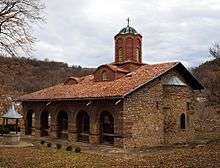 |
Veliko Tarnovo | Bulgaria | 1218–1241 | Bulgarian Orthodox Church | Medieval Bulgarian Orthodox church in the city of Veliko Tarnovo in central northern Bulgaria, the former capital of the Second Bulgarian Empire. The 13th-century church lies at the foot of the Tsarevets hill's northern slopes and was reconstructed in 1981. The church is dedicated to the Christian Apostles Saint Peter and Saint Paul. It follows the cross-domed design and has a single apse. The cella is divided into three naves by two rows of columns. The columns' capitals are decorated with plastic carving and tracery. The church has a high, massive iconostasis. According to the 14th-century account of Patriarch Evtimiy, the church and the surrounding monastery were built on the order of Tsar Ivan Asen II's (ruled 1218–1241) wife Anna.[63] |
| Ascension Cathedral (Veliko Tarnovo) | Veliko Tarnovo | Bulgaria | 1331–1371 | Bulgarian Orthodox Church | Reconstructed Eastern Orthodox cathedral in the city of Veliko Tarnovo, in north central Bulgaria. Located on top of the fortified Tsarevets hill in the former capital of the Second Bulgarian Empire, the cathedral was the seat of the Bulgarian patriarch from its construction in the 11th–12th century to its destruction in 1393. Standing on top of a late Roman church, the cathedral, reconstructed in the 1970s and 1980s, follows a cross-domed plan with a bell tower and a triple apse. Richly decorated on both the exterior and interior, its internal walls now feature modern frescoes, the presence of which has meant that it has not been reconsecrated. Though not active as a Christian place of worship, it has been open for visitors since 1985.[64] | |
| Church of Christ Pantocrator, Nesebar | 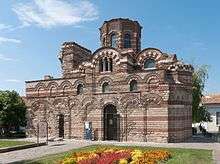 |
Nesebar | Bulgaria | 1331–1371 | Bulgarian Orthodox Church | Medieval Eastern Orthodox church in the eastern Bulgarian town of Nesebar (medieval Mesembria), on the Black Sea coast of Burgas Province. Part of the Ancient Nesebar UNESCO World Heritage Site, the Church of Christ Pantocrator was constructed in the 13th–14th century and is best known for its lavish exterior decoration. The church, today an art gallery, survives largely intact and is among Bulgaria's best preserved churches of the Middle Ages.[65][66] |
| Church of Saint Paraskevi, Nesebar | Nesebar | Bulgaria | 1331–1371 | Bulgarian Orthodox Church | Partially preserved medieval Eastern Orthodox church in Nesebar (medieval Mesembria), a town on the Black Sea coast of Burgas Province in eastern Bulgaria. It was most likely built in the 13th or 14th century and forms part of the Ancient Nesebar UNESCO World Heritage Site. The Church of Saint Paraskevi features a single nave and a pentagonal apse as well as rich exterior decoration. Its dome and the belfry surmounting the narthex have not been preserved today, and it is unknown which of the three saints named Paraskevi it was dedicated to.[67] |
- Christ Church Cathedral, Dublin, Ireland, built c. 1030
- St. Margaret's Chapel, built in the 11th century, possibly the oldest church building in Scotland
- Saviour Cathedral (Chernihiv), Ukraine, built in the 1030s
- Saint Sophia Cathedral (Kyiv), Ukraine, built in the 1030s
- Saint Cyril's Monastery (Kyiv), Ukraine, founded in 1140
- Arkhyz churches, Russia, 10th to 13th centuries
- Novgorod Cathedral, Russia, built between 1045 and 1050
- Old Aker Church (Norwegian: Gamle Aker kirke) is a medieval church located in Oslo. An active parish, the church is the oldest existing building in Oslo from 1080.
- Church of the Holy Sepulchre, rebuilt in 1089, in Jerusalem is venerated as Golgotha (the Hill of Calvary), where Jesus was crucified, and is said also to contain the place where Jesus was buried (the Sepulchre) (some walls from earlier structure may exist), (Greek Orthodox, Roman Catholic, Armenian Apostolic Orthodox, Syrian Orthodox, Coptic Orthodox, and Ethiopian Orthodox)
- Church of St. Adalbert, Kraków, Kraków, Poland, built in the 11th century, possibly the oldest church building in Poland
- Saint Sophia Cathedral in Polotsk, Belarus, 18th-century building with an 11th-century apse
- Abbey of Romainmôtier: a 5th-century church was rebuilt in the 7th century, and again between 990 and 1030. The church building remained mostly unchanged since the 11th century, and qualifies as one of the oldest romanesque buildings in Switzerland.
- Lund Cathedral, built in 1123, Possibly the oldest church in Sweden (although part of Denmark in 1123) (formerly Catholic, now Lutheran)
- St. Mary's Cathedral, Limerick, Ireland, founded in 1168.
- St. Peter's Church, Hamburg & St. Nicholas' Church, Hamburg, Hamburg, Germany, Building Started 1189 but were rebuilt several times due to fire & war but still stand in their original positions today.
- St. Audoen's Church, Dublin, Ireland, founded in 1190.
- St. Patrick's Cathedral, Dublin, Ireland, founded in 1191.
- Church of Saint George, Lalibela, Ethiopia, Built in the 12th century, one of the oldest church buildings in Ethiopia (Ethiopian Orthodox Church)
- Church of St. Panteleimon (Nerezi), built in the 12th century, One of the oldest church buildings in Macedonia
- Kalozha Church, the oldest extant church building in Belarus, 12th century.
- Church of Kish, the oldest extant Caucasian Albanian church building in Azerbaijan, 12th or 13th century.
- Basilica of Saint Servatius, church congregation dating to 384 AD, current building built from 11th to 13th centuries, oldest congregation and possibly the oldest church building in the Netherlands (Roman Catholic)
- Thiruvithamcode Arappally (Arappally means Royal Church) Kanyakumari District is the oldest Church building that still exists in India.
- St. Canice's Cathedral, Kilkenny, Ireland, built between 1202 and 1285.
- St. Nicholas Church, Vilnius, Lithuania, is the oldest surviving church in Lithuania. Originally built in the 14th century.
- Hvalsey Church, located in Hvalsey (modern-day Qaqortoq), Greenland, Kingdom of Denmark, is the oldest surviving church (no longer in use, in ruins) in the Americas. Originally built in the 14th century as a Catholic church, although archaeology suggests it was constructed on the site of a previous church.
- Trondenes Church, (Norwegian: Trondenes kirke) is the northernmost medieval stone church of Norway and the world's northernmost surviving medieval building. Finished and opened in 1435.
Early Modern
Notable early churches built in the New World between the 15th and 19th centuries. Listed are especially the oldest extant church buildings by country.
- St. Francis Church, Kochi, India, built 1504–1516, oldest European church building in India (Church of South India)
- Catedral de Santa María la Menor, commissioned by Pope Julius II in 1504, and built 1514–1540. It is the oldest church in the Americas and the oldest church building in the Dominican Republic (Roman Catholic)
- St. Paul's Church, Malacca, Malaysia, built in 1521 as a Roman Catholic chapel and finally abandoned in 1753. It is the oldest known church building in Malaysia
- Cathedral of San Juan Bautista, Puerto Rico, built in 1521, oldest church building in the United States (Roman Catholic)
- Chapel of Ermita del Rosario, Mexico, built in 1523, oldest chapel in Mexico
- The church of La Balbanera, Ecuador, was constructed in 1534, making it the oldest church constructed by the Spaniards in Ecuador
- Chapel of San Jacinto, Guatemala, founded in 1524, one of the oldest churches in Guatemala (Roman Catholic)
- Franciscan Chapel of the Red Cross, Jamaica, built in 1525, one of the oldest Spanish cathedrals in the New World (Roman Catholic)
- St. Dominic's Church, Macau, China, built in 1527 by three Dominican Priests (Roman Catholic)
- Church of Saints Cosme and Damião, built in 1535, in the city of Igarassu, Pernambuco. Brazil's oldest church (Roman Catholic).
- Cebu Metropolitan Cathedral, Cebu, Philippines established in 1565, previously named as the Church of St. Vitales and is the first church erected in the Philippines.(Roman Catholic)
- Mexico City Metropolitan Cathedral, built 1574–1813, one of the oldest churches in Mexico (Roman Catholic)
- Old West Kirk, Greenock, 1591, the first Protestant church built in Scotland post Reformation (Church of Scotland)
- Cathedral of the Immaculate Conception in Beijing, founded in 1604, possibly the oldest continuous church congregation in China (Roman Catholic)
- San Agustin Church, Manila, built in 1607, one of the oldest church buildings in the Philippines. (Roman Catholic)
- First Jamestown Church (foundations), 1607, first Protestant church in what would become the USA (Episcopal)
- San Miguel Mission, Santa Fe, New Mexico, USA, built in 1610, oldest church building in the continental U.S. (Roman Catholic)
- Ruins of St. Paul's, China, built in 1627 (Roman Catholic)
- St. James Church, Barbados, founded 1627, oldest congregation in Barbados (Anglican)
- St. Luke's Church, USA, built in 1682 (Episcopal)
- Jamestown Church (tower), (Episcopal)
- Old Ship Church, USA, built in 1681 (Congregationalist, later Unitarian)
- Notre-Dame-des-Victoires, Quebec City, built 1687–1723, later extensively rebuilt, Possibly the oldest church building in Canada (Roman Catholic)
- Zion Church, Jakarta, Indonesia, the church was built in 1695, the oldest standing church structure in the city.
- Cathedral of San Fernando, San Antonio, Texas, USA, built between 1738 and 1750, the oldest cathedral sanctuary in the United States
- St. Paul's Church (Halifax), built 1750, Possibly the oldest Protestant church building in Canada (Anglican)
- Blenduk Church, built in 1753 complete with a Baroque Organ from the 18th century, it is the oldest church in Central Java, Indonesia.
- Christ Church Melaka, built in 1753 as a Dutch Reformed church, it now houses an Anglican congregation. It is the oldest Protestant church building in Malaysia
- Mission San Diego de Alcalá, built in 1769 by Junipero Serra, is a functioning Roman Catholic church and the oldest in California (United States). It sits at the base of El Camino Real, the road going northward in California that is punctuated by missions about a day's walk apart.
- St. Anne's Church, constructed by the Portuguese in 1792, built in European and Gothic styles, one of the oldest Churches in South India, in Virajpet, Coorg.[68]
- Her Majesty's Royal Chapel of the Mohawks, constructed in 1785 for the Mohawk people led by Joseph Brant, first Protestant church in Upper Canada (Anglican)
- Church of the Holy Ascension, USA, built in 1826, oldest church building in Alaska (Russian Orthodox)
- Armenian Church, Singapore, built 1835, oldest church in Singapore
- Mokuaikaua Church, USA, built in 1837, oldest church congregation and building in Hawaii (Congregational)
- Christ Church Royal Chapel, established in 1784, built in 1843 by the Mohawk people to symbolise their alliance with the British Crown (Anglican)
- Saigon Notre-Dame Basilica, Possibly oldest church building in Vietnam, built 1863–1880 (Roman Catholic)
- Ōura Church, built in 1864, Possibly the oldest church building in Japan (Roman Catholic)
- Wanchin Basilica of the Immaculate Conception, Taiwan, built in 1870, oldest chapel in Taiwan (Roman Catholic)
- Myeongdong Cathedral, built between 1892–1898, Oldest church building in South Korea (Roman Catholic)
- Living Water Church, built 1909, One of the Oldest Pentecostal Church buildings in the World. Built 3 years after Azusa St. Revival in San Francisco, 1906 (Charismatic Church)
See also
- Church architecture
- Church (building)
- List of the oldest buildings in the world
References
- "To the time of Constantine (71–312)". Catholic Encyclopedia. Retrieved 15 November 2013.
Certainly no spot in Christendom can be more venerable than the place of the Last Supper, which became the first Christian church.
- Silver, Carly (11 August 2010). "Dura-Europos: Crossroad of Cultures". Archaeology. Retrieved 16 November 2013.
- Rose, Mark. "Early Church at Aqaba". Retrieved 31 January 2014.
- Stokes, Jamie, ed. (2008). Encyclopedia of the Peoples of Africa and the Middle East. New York: Infobase Publishing. p. 65. ISBN 9781438126760.
Etchmiatzin is located in the west of modern Armenia, close to the border with Turkey, and its fourth-century cathedral is generally regarded as the oldest in the world.
- Dhilawala, Sakina (1997). Armenia. New York: Marshall Cavendish. p. 72. ISBN 9780761406839.
Echmiadzin Cathedral is the spiritual center of the Armenian Church and the seat of the Catholicos of all Armenians. It is also the oldest cathedral and Christian monastery in the world.
- Bauer-Manndorff, Elisabeth (1981). Armenia: Past and Present. Lucerne: Reich Verlag.
Etchmiadzin, with the world's oldest cathedral and the seat of the Catholicos, draws tourists from all over the world.
- Utudjian, Édouard (1968). Armenian Architecture: 4th to 17th Century. Editions A. Morancé. p. 7.
...he also wanted to contribute to the restoration of the oldest cathedral in Christendom, that of Etchmiadzin, founded in the 4th century.
- Horne, Charles Francis (1925). The World and Its People: Or, A Comprehensive Tour of All Lands. New York: I.R. Hiller. p. 1312.
A far more interesting relic in this Russian section of Armenia is the old monastery of Etchmiadzin. It has been in constant use since the founding of Christianity in Armenia in the third century of our era, and is thus the oldest Christian monastery in the world today.
- Bryce, James, Viscount (1896). Transcaucasia and Ararat, being notes of a vacation tour in the autumn of 1876, by James Bryce. London: Macmillan and Co. LTD. p. 311.
...the famous monastery of Etchmiadzin, which claims to be the oldest monastic foundation in the world...
- Qara Kelisa, the feast of St Thaddeus of the Armenians in the oldest church in the world (photos), asianews.it
- The Armenian Monastic Ensembles in Iranian Azarbayjan, UNESCO, 2007
- Armenian monastic ensembles (Iran) No 1262, UNESCO - May 25, 1997
- St. Thaddeus Monastery, Armeninan church in Iran ,jerusalem-lospazioltre.it
- Edward Denison, Edward Paice (2007). Eritrea: The Bradt Travel Guide. p. 187. ISBN 978-1841621715.CS1 maint: uses authors parameter (link)
- J.L. Teicher, "Ancient Eucharistic Prayers in Hebrew (Dura-Europos Parchment D. Pg. 25)", The Jewish Quarterly Review New Series 54.2 (October 1963), pp. 99–109
- The Ancient Church at Megiddo: The Discovery and an Assessment of its Significance E Adams – The Expository Times, 2008 "... chronologically distinct. The structure at Megiddo is obviously not a basilica. According to Tepper, the Megiddo church is a unique ecclesiastical form. It could not have resembled the church buildings of the late third century."
- McGreal, Chris (7 November 2005). "Holy Land's 'oldest church' found at Armageddon". The Guardian. Retrieved 14 September 2015.
- "Early Church at Aqaba – Archaeology Magazine Archive". Retrieved 21 December 2016.
- "First purpose-built church". Retrieved 21 December 2016.
- "Maalula Monasteries, Syria". sacred-destinations.com. Retrieved 14 September 2015.
- Oborne, Peter (15 April 2014). "Syria war: Maaloula's monastery destroyed after Assad forces drive rebels out". The Daily Telegraph. London.
- The damage done to 'Syria's oldest church' seen first hand The Daily Telegraph, by Christine Marlow. 16 October 2013
- "4th Century Assyrian Church in Saudi Arabia". Assyrian International News Agency. 28 August 2008. Retrieved 14 September 2015.
- Clyde E. Fant, Mitchell Glenn Reddish, A guide to biblical sites in Greece and Turkey (Oxford University Press US, 2003), pg. 149
- Ιερά Μονή Σταυροβουνίου, Έκδοση Ιεράς Μονής Σταυροβουνίου, 1998, Λευκωσία, Κύπρος. ISBN 9963-615-02-3 (In Greek).
- "Pre-Constantinian Necropolis". Vatican City State. Retrieved 14 September 2015.
- Administrator. "Temple's History". Retrieved 21 December 2016.
- "Rome attractions : Rome Churches and Basilicas Guide". Hoteldesartistes.com. Retrieved 2012-06-13.
- "Santa Maria in Trastevere". Rome-explorer.com. Retrieved 2012-06-13.
- info@arte.it, ARTE.it Srl -. "Basilica di San Nazaro Maggiore (detta in Brolo) di Milano – Chiesa – Arte.it". Retrieved 21 December 2016.
- "Papal Basilica – Saint Paul Outside-the-Walls". Retrieved 21 December 2016.
- "Case Romane del Celio" (in Italian). Case Romane del Celio. Archived from the original on 23 September 2014. Retrieved 14 September 2015.
- "Trier, Basilica – Livius". Retrieved 21 December 2016.
- Truglio, Maurizio. "Chiesa di San Nereo e Achilleo a Roma: foto e storia". Retrieved 21 December 2016.
- "Basilica di Santa Pudenziana". Archived from the original on 6 November 2016. Retrieved 21 December 2016.
- "About Chora". 26 July 2011. Retrieved 21 December 2016.
- "Hagia Eirene – Istanbul, Turkey". Retrieved 21 December 2016.
- Ibrahim, Raymond. "Christendom's Greatest Cathedral to Become a Mosque". Retrieved 21 December 2016.
- Otto, Randall (Spring 2001). "Care For The Dying: The Church and Hospice". Quodlibet Journal. Scott David Foutz. 3 (2). ISSN 1526-6575. Archived from the original on 2014-10-14. Retrieved 2015-08-17.
- Inc., Tom Brosnahan, Travel Info Exchange. "Little Hagia Sophia (Küçük Ayasofya), Istanbul, Turkey". Retrieved 21 December 2016.
- "Turkey turns iconic Istanbul museum into mosque". BBC News. 2020-07-10. Retrieved 2020-07-17.
- "Religious buildings with the "Culture Monument" status". Republic of Albania National Committee for Cult. Retrieved February 1, 2015.
- "Labovë e Kryqit". Retrieved 21 December 2016.
- "Archived copy". Archived from the original on 2014-10-22. Retrieved 2014-10-22.CS1 maint: archived copy as title (link)
- "The church of St. Peter-on-the-Wall, Bradwell-on-Sea, Essex", Anglo-Saxon Churches, accessed 4 July 2016.
- Historic England. "The Saxon Church (Grade I) (1292122)". National Heritage List for England. Retrieved 9 April 2018.
- Historic England. "Church of All Saints (Grade I) (1054866)". National Heritage List for England. Retrieved 23 June 2015.
- http://fakti.bg/kultura-art/141654-vazstanovavaneto-na-golamata-bazilika-oznachava-pamet-rodolubie-i-turizam
- Boris Cholpanov – "Land of a global crossroads", Sofia, 1993, Bulgarian Academy of Science, page 131 (the original is in Bulgarian)
- "Doubts Raised About Ancient Christian Shrine in Jordan". Fox News. 12 June 2008.
- ""Oldest Church" Discovery "Ridiculous," Critics Say". Retrieved 21 December 2016.
- McGrath, Matt (10 June 2008). "Jordan cave may be oldest church". BBC News.
- Monuments of Syria: A Guide By Ross Burns. Google Books.
- "friendsofsyria.co". Retrieved 21 December 2016.
- ".:Middle East Online:::". Retrieved 21 December 2016.
- romeartlover. "The Breath of God: Ezra". Retrieved 21 December 2016.
- "Come to Syria – Ezraa – Archeological Places in Syria – – Come To Syria". Retrieved 21 December 2016.
- "St Mary's Forane Church Kaduthuruthy". Retrieved 21 December 2016.
- "Worth Church". Archived from the original on 3 February 2011. Retrieved 21 December 2016.
- "Sveriges kvalitetssajt för nyheter". SvD.se (in Swedish). Retrieved 2020-08-11.
- Church of St Demetrius of Thessaloniki, Veliko Tarnovo
- Holy Forty Martyrs Church, Veliko Tarnovo
- Church of Saints Peter and Paul, Veliko Tarnovo
- Ascension Cathedral (Veliko Tarnovo)
- Kay, Annie (2008). Bulgaria: The Bradt Travel Guide. Bradt Travel Guides. p. 265. ISBN 978-1-84162-155-5.
- Church of Christ Pantocrator, Nesebar
- Church of Saint Paraskevi, Nesebar
- "A Tower, a Church and a Waterfall". orangecounty.in. Retrieved 12 June 2016.